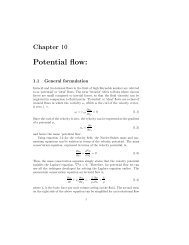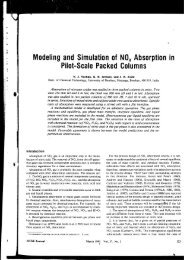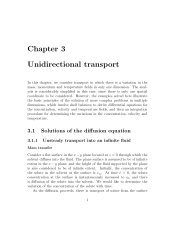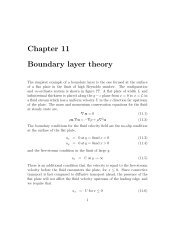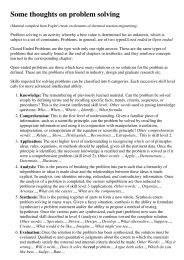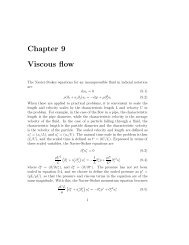Chapter 5 Steady and unsteady diffusion
Chapter 5 Steady and unsteady diffusion
Chapter 5 Steady and unsteady diffusion
Create successful ePaper yourself
Turn your PDF publications into a flip-book with our unique Google optimized e-Paper software.
10 CHAPTER 5. STEADY AND UNSTEADY DIFFUSION<br />
Note that the solution for the temperature, 5.35 does not depend on the<br />
radius of the sphere, but only on the total amount of heat generated per unit<br />
time from the sphere. If the object that generates the heat were some other<br />
irregular object, then the temperature field would depend on the dimensions<br />
of the object. However, if we are sufficiently far from the object, so that the<br />
distance from the object is large compared to the characteristic length of the<br />
object, the object appears as a point source of heat, <strong>and</strong> the observer cannot<br />
discern the detailed shape of the object. In this case, it is expected that the<br />
temperature distribution will not depend on the dimensions of the object,<br />
but only on the total heat generated per unit time. Mathematically, a point<br />
source of energy located at the position x 0 is represented by a delta function,<br />
5.2.2 Dirac delta function<br />
S(x) = Qδ(x − x 0 ) (5.36)<br />
The one-dimensional Dirac delta function, δ(x), is defined as<br />
<strong>and</strong><br />
∫ ∞<br />
δ(x) = 0 for x ≠ 0 (5.37)<br />
∫ ∞<br />
dxδ(x) = 1 (5.38)<br />
−∞<br />
−∞<br />
dxδ(x)g(x) = g(0) (5.39)<br />
It is clear from equation 5.39 that δ(x) has dimensions of inverse of length.<br />
The delta function can be considered the limit of the discontinuous function<br />
(figure 5.4)<br />
f(x) = (1/h) for(−h/2 < x < h/2) (5.40)<br />
in the limit h → 0. In this limit, the width of the function tends to zero,<br />
while the height becomes infinite, in such a way that the area under the<br />
curve remains a constant. It is clear that the function f(x) satisfies all three<br />
conditions, 5.37 to 5.39, in the limit h → 0.<br />
In a similar fashion, the three dimensional Dirac delta function, δ(x 1 , x 2 , x 3 )<br />
is defined by<br />
δ(x 1 , x 2 , x 3 ) = 0 for x 1 ≠ 0; x 2 ≠ 0; x 3 ≠ 0 (5.41)<br />
∫ ∞ ∫ ∞ ∫ ∞<br />
dx 1 dx 2 dx 3 δ(x 1 , x 2 , x 3 ) = 1 (5.42)<br />
−∞<br />
−∞<br />
−∞





